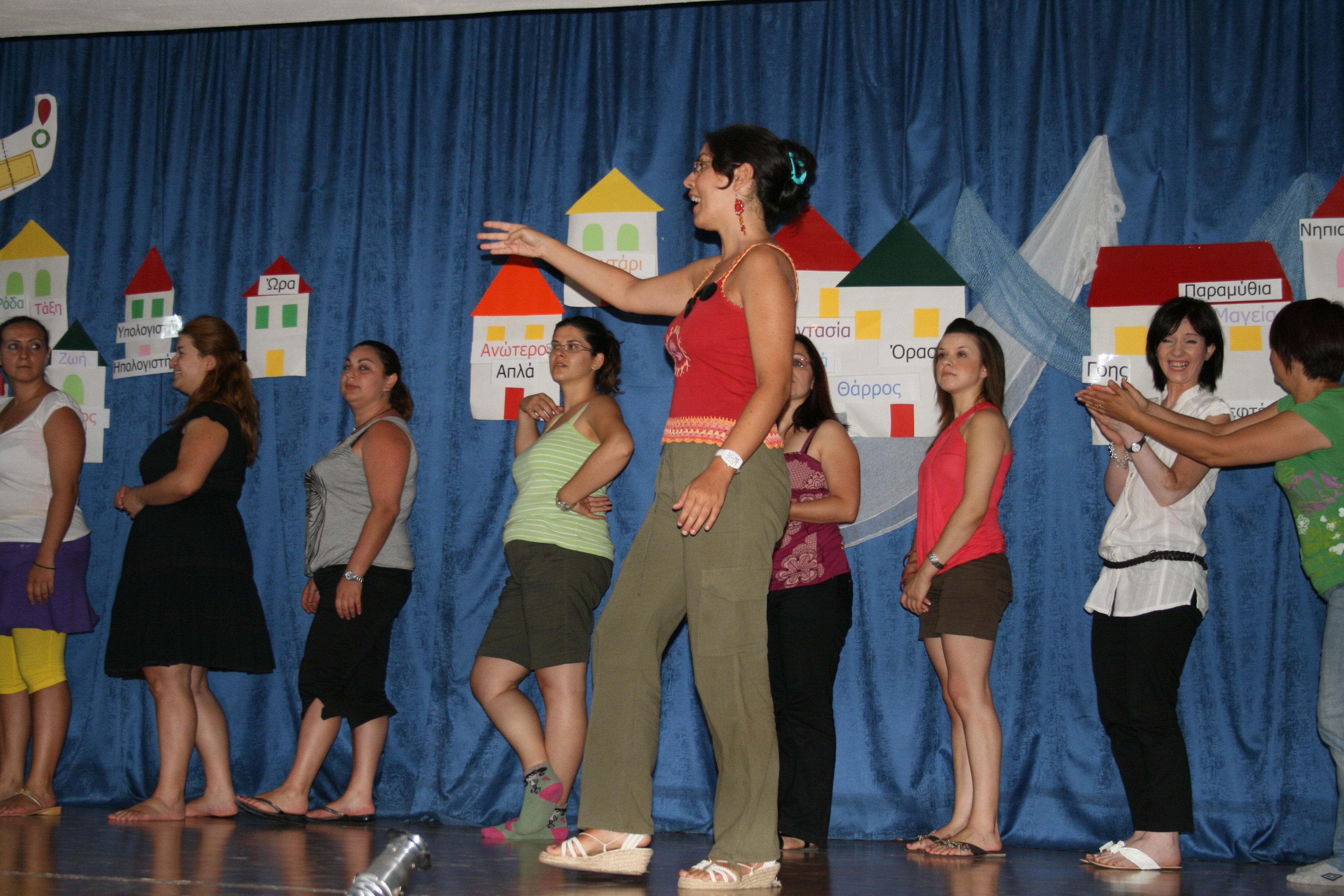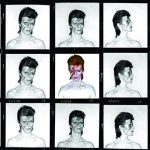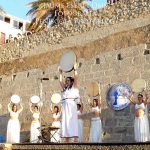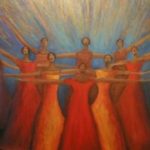(leer artículo en castellano) Dhanmeet Eirini Delaki fuses the disciplines of Spiritual Theatre, Kundalini Yoga and Sacred Percussion to create sacred experiences and performances. She uses the term Spiritual Theatre to express this act of channelling creative energy as a supreme art. Eirini has been developing this concept since 2006 with Spiritual Theatre workshops, performances and plays in various territories including Spain, India, Nepal, England, Ireland, Austria, Greece and her native Crete. These proposals have been warmly supported by the Spanish Association of Kundalini Yoga, the University of Valencia, the Manipal University Hospital in Nepal, the “DiversiTO” , “Life is theatre, we are Actors”, and “Where the Rivers Meet” international projects of the European Commission and numerous cultural and spiritual associations. Eirini’s investigation in the intrinsic relationship between spirit and art and the deep effectiveness of Kundalini Yoga led her to create the Kundalini Yoga and Art Festival in 2013 in Greece, and currently in Spain. This pioneering annual festival brings together facilitators and practitioners from around the world for workshops, building community and sharing ideas and experiences which emerge through the fusion of the arts, such as music, theatre, visual arts and dance with Kundalini Yoga.
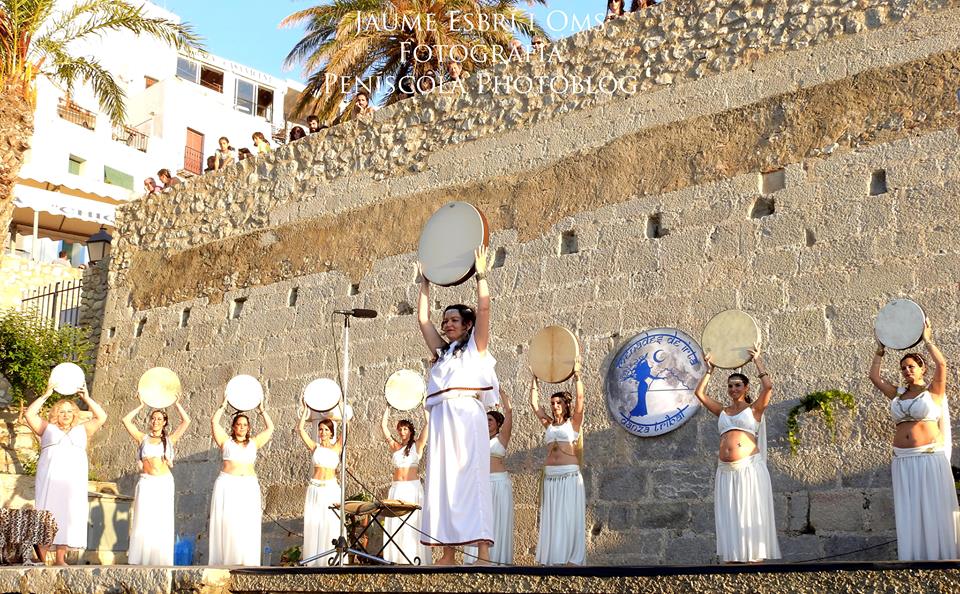
The use of Kundalini Yoga in theatre facilitation
Theatrical experiences in several countries have played a transformative role in my personal and professional development, yet at times they left me with a sense that something was lacking, which did not allow the experience to vibrate at a cellular level. The question that kept returning to my mind and heart was, “What would take my theatre practice beyond social and political ideologies with a focus on the individual – not in a self-centred way, but as an ingredient for personal and community transformation, an experience of a deep level of existence?” The combination of Kundalini Yoga as taught by Yogi Bhajan and different theatre techniques, with a focus on the teachings of Augusto Boal (Theatre of the Oppressed), has answered this question for me. My purpose is the application of theatre techniques as a practical tool for exploration of interpersonal and social issues, such as racism, addictions, etc. but also more abstract ideas such as peace, or love.
Role of the participants and facilitator
In 2008, I began working on collective creations where all the participants are organically involved by offering pieces of inspiration that join together in a final result: a collective action guided by the facilitator who acquires the role of the group tuner. The facilitator is not a stage director according to the conventional meaning of the word. She gives the necessary guidance for the group to discover and express their creative potential without imposing anything on anybody. She opts for spontaneity and naturalness, and provides the necessary axis for the group around which the creation moves.
Kundalini Yoga: the yoga of awareness
Kundalini Yoga is an ancient spiritual practice that in our case is applied as an introspective incubator. The use of different components of this type of yoga helps participants to connect with themselves at bodily, psychic, mental and spiritual levels and in preparation for a more organic theatrical experience. This effect is achieved through the kriyas. The word kriya in Sanskrit means “action”. It is described as “a sequence of postures, breathing and sound integrated together to allow the manifestation of a particular state” (Bhajan, 2006). If, for example, our goal is to develop the ability of projection and expansion of the group, we apply a kriya designed for this purpose. In this case it could be the Nabhi kriya.
A basic ingredient of this process is the asanas (postures). “The asana is used to isolate specific muscles, to pressurize concrete points or areas that act as triggers of reflexes in order to enhance the performance of the glands and organs, and to redirect the flow of or increase circulation” (Bhajan, 2006). This experience makes our nervous system vibrate and results in removing body blockages and changing repetitive thought patterns and attitudes that inhibit our creativity and expansion.
Breath by breath
Another essential ingredient of this procedure is the breath, which is an integral part of the asanas and meditation. Breathing movements are connected to the movement of all our emotions and thoughts. In fact, by controlling the breath through specific techniques, we channel our emotions and thoughts in such a way that tension caused by emotional stress is liberated, the vital organs are oxygenated, our creativity range expands, concentration is developed and different moods come under a conscious spectrum to be transformed. In addition, as sound is transmitted through breathing, our voice projection becomes more direct and clear and a wide range of sounds and rhythms is developed.
“The mind is considered to be the connection between body and consciousness. It´s the habits of the mind that bind us to the attachments and duality and therefore to suffering” (Bhajan, 2006).
Living life and experiencing theatre through a meditative state involves applying the art of breaking toxic habits in order to purify the mind and live/create intuitively and smoothly.
Meditation facilitates this process through stillness and mantra. The stillness that the body experiences during meditation obliges our energy not to disperse. We then pay attention to body blockages whose symptoms are reflections of psychological blocks. Recognizing these blocks, with time and practice, we learn to identify them, and this constitutes the first step towards a more intuitive and expansive attitude.
The power of mantra
The use of mantras increases this attitude. Mantras are words or phrases which are recited out loud or internally in a rhythmic and repetitive way as a way to reach a meditative state. They are pulsating vibrations in our body which cause profound changes at the level of our cellular system. For example, vibrating the mantra “sa re sa sa, sa re sa sa, sa re sa sa sa rang / harare har har, harare har har harare har har har ang”, pressure applied by the tongue on the palat activates our pituitary gland which is responsible for intuition and creation.
Reaching beyond personal limitations into collective creation
The benefits of meditation applied in the theatrical process can be summarized as mental clarity, comfort, release of blockages, ability to focus energy and project our feelings, ability to be present in the here and now, clear and accurate projection of our voice and energy, organic production of different sounds.
Once the participant dominates a kriya, i.e. a set of asanas, breathing and sound (mantra), she acquires physical and emotional strength and develops the ability to complete tasks. In order to complete a kriya a quite arduous effort is required; in fact, it´s a challenge that makes us face our limits, resistances and, as a result, our ego. Once this task is completed, the participant may be immersed in the theatrical experience not through a selfish focus, but through openness to what the group as a whole generates and, therefore, a collective creation may be processed more easily. The group enters a state of entrainment, synchronized spontaneous flow, a state that leads it to a more profound and subtle experience of its own being. At this point, the theatre games and exercises come to complete the process carried out through Kundalini Yoga.
Participants and conflict resolution
Participants are usually not professional actors. They are groups who seek an internal or external conflict resolution that affects one or more facets of their lives, such as drug addicts, abused people and teenagers. They are also participants who want to artistically express abstract ideas such as peace or love, explore their creative potential and express themselves through drama. During the workshops I use games and exercises related to the development of the five senses, in a random way, according to the needs of the participants. Their purpose is to sharpen the five senses, to anchor participants in the here and now and prepare them for a collective creation through their 6th sense, an intuitive and spontaneous play/performance. This creation is related to the message they want to convey and its projection in the most concrete and direct way possible.
These participants decide how to represent different scenes in a concrete manner with the help of the facilitator. For example, in a workshop in Greece in 2009 exploring femininity, the participants created images related to the conflict of the sexes and the issue of equality: a man giving orders to a woman, or the opposite.
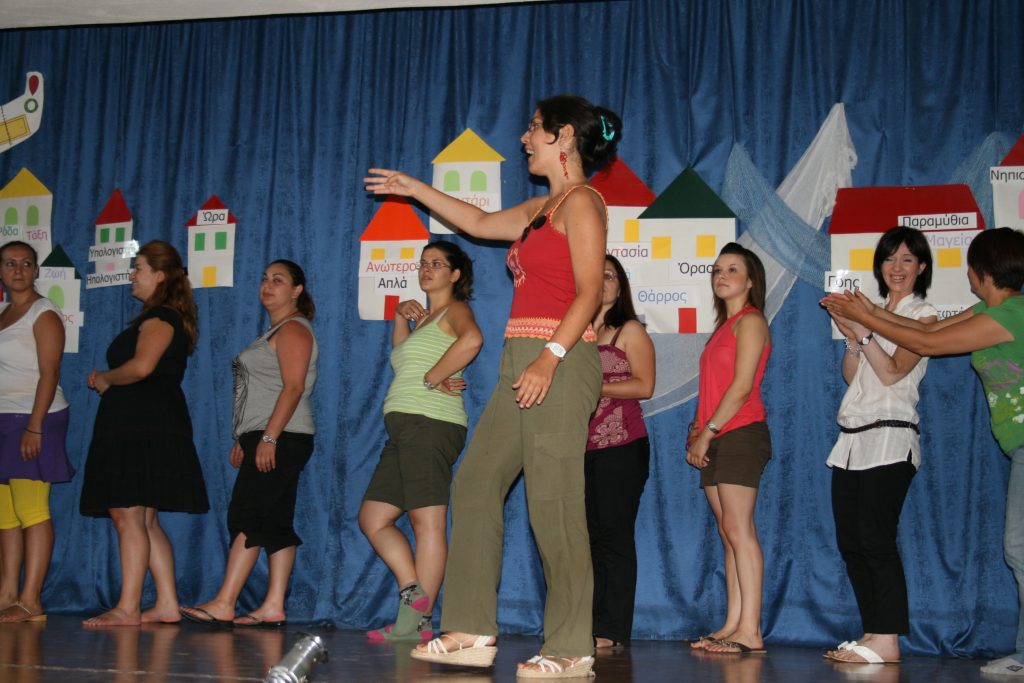
Each scene is approached in a way that seeks the essence of the conflict represented in order to transform it. If necessary, the scenes are rehearsed again and again until the participants take a distance from the situation represented, which may have been part of their lives and affect them emotionally, therefore achieving a similar effect to meditation. Not only do they face the conflict effectively, but they are also prepared to live a more fulfilling artistic experience by being able to observe themselves in action since they do not identify with toxic thoughts and feelings generated by the represented conflict.
I have applied the Spiritual Theatre proposal in different cultural contexts. Here are two examples:
The project in Pokhara, Nepal
During the summer of 2008 I developed a Spiritual Theatre project in Pokhara, Nepal. I worked with some children from the Annapurna Self Sustaining Orphan Home. Our aim was to create a play about the consequences of Nepal´s health system, a system that ignores people from lower castes to such an extent that deprives them of even basic medication such as paracetamol or aspirin. Belonging to lower castes in Asian countries means that one is not only a member of a lower social class, but also that he should be ignored by others, because his poverty has been caused due to having done something negative in his previous life. Thus, religion and the feeling of guilt are deeply rooted in the life of those castes.
The workshop participants were children aged 8 to 12 years old who had ended up at the orphan home for different reasons. Some had parents who were infected by HIV/AIDS virus, other parents belonged to different castes – it is generally unacceptable to mix high with low castes – and others had lost their parents in political assassinations.
Connecting with nature and the body
Following the procedure described, using Kundalini Yoga and theatre techniques, we worked for two months creating an improvised play which ended up having the title “The Carving on the Tree”. The relationship of people with nature in the East is much closer than in the West. People are used to doing their daily activities more in the open air than in closed places. In fact, the workshops were held in the yard of the children´s home and by the banks of the nearby river. The river landscape was particularly useful during the preparatory phase before the play, since nature enhances relaxation and helps establish a deeper contact with our creativity. During the practices of Kundalini Yoga, the participants responded to the exercises with ease. They weren´t experienced in this kind of yoga, but they were trained in diverse spiritual practices such as hatha yoga and various types of meditation, both Hindu and Buddhist.
It is also true that in Asia people generally have a more direct relationship with their bodies than in the West. They are characterized by a more intense physicality. This is because from an early age most of the population is involved in spiritual practices that train the body. Music and dancing are also an integral part of their daily lives. People sing and dance not only during special occasions, but any time they need to express their feelings, release tension, praise their god, or just have fun. Rhythm is a feature that is manifested in all the aspects of their life. The above fact reduced the need for many exercises of body expression during the preparatory workshops. However, what proved to be essential was the use of a considerable number of coordination exercises and games. During certain sessions it was absolutely necessary to apply these exercises to achieve the tuning in of the group that tended to disperse. There used to be a chaotic atmosphere that reflected the atmosphere of their own lives and the society they had been brought up in.
Expressing emotion
During the improvisation, the children expressed their feelings with surprising ease. Extroversion and sense of community are key features of societies like Nepal´s. People are generally open to collective forms of expression. They live in groups where they share their sorrows, their art, food, and support each other. In fact, participants did not find it difficult to express themselves in group. However, it was necessary to refine their expression through yoga and theatre. At times the expression of their feelings was so sudden and aggressive that their peers underwent the risk of physical and verbal violence. The children were not aware of that impulse as they simply didn´t know how to channel the anger they felt due to their life experiences. The role of theatre in this case was the transformation of that impulse into spontaneity, making them realize that it makes no sense to go against anything or anyone.
Our performance, “The Carving on the Tree”
The result of facilitation during those two months of practice was an improvised play that narrates the story of a low caste parent seeking help to heal his seriously ill son. The work reflected the negative impact of the health system in Nepal in the lives of the people belonging to lower castes, like the children of the orphan home. It also invited the audience to offer practical solutions for this unfair situation.
During the performance different options were proposed, both on behalf of the actors and the audience. The option that emerged as resolution of the problem was individual initiative. The play was enriched with ethnic music from different countries and an improvised dance at the end. The scenery was simple, made with existing resources and the costumes were created by students and their parents using recycled clothes.
Presentation and positive social repercussions
The work was presented at the theatre of Parvati boarding school and of Manipal university hospital of Nepal. The audience showed considerable interest in the play and opened up to the situation of the children. It consisted mainly of children and adolescents with their parents and professionals of medicine and therapy in general. After the presentations the audience donated school supplies, second hand clothing, other useful items for the children and money. The hospital offered free vaccinations and checkups for the children on a regular basis, as well as a donation made by its employees. Thanks to the donation, English classes were paid for the children, which is a very useful skill in touristic countries such as Nepal.
Spiritual Theatre and the West
An example born in the Western context is a Spiritual Theatre project with the NGO Ingenieros sin Fronteras in Valencia, Spain. The project was conducted during the academic year 2009-2010 under the theme of the global water crisis. Participants were university students who came from different parts of Spain, aged between 20-25 years old. The result of the process was a performance with the title “Water Up to the Neck”.
Western needs and attitudes
One aspect of the group, which was quite surprising for their age, was the stiffness noticed during the physical training exercises in most of the participants. The signs of a sedentary life and psychological blocks were obvious. In most cases the blocks were due to the difficulty of communicating with others; one problem of our Western societies is individualism.
The application of yoga in some cases was treated with openness and curiosity. It was a new way for the students to experience and understand themselves. Some had already been taught yoga or tried spiritual practices. However, in other cases it was met with skepticism. Precisely because it was something completely new that obliged the body and mind to take an unusual attitude which is not habitual in our modern life, a sense of discomfort was caused that eventually dissolved after a certain time of practice, giving way to a deeply enjoyed experience and performance.
Whilst in Nepal the challenge was to channel and control emotions once they were manifested, in Spain it was to help them to manifest. The result is the inhibition of our feelings, guilt and an increasing sense of loneliness. The theatre games were a response to this challenge. Once the emotions were released, it was quite easy to communicate naturally, begin to improvise, and work on building the scenes of what was to be our performance.
Global water crisis in theory and interpretative action
Alongside the practical work of training, we also developed theoretical work. It was a collective research about the global water crisis. While studying information, we adapted it to the scenes to give our views on this subject as concisely and concretely as possible. During the research, the participants showed organizational ability and interest in knowing more about the water crisis not only in Spain but also worldwide. At the same time we studied water as an essential element for life and happiness, a natural resource that also inspires, relaxes and has a spiritual dimension.
Presentation and social repercussions
The performance was about a journey between past and present regarding the use of water as a resource through some moments of the life of a family and an old farmer. The performance was created and presented through image theatre techniques using only sounds that expressed the state of the protagonists. The sounds were emitted by the students themselves or were electronically composed and reproduced by participants as a soundtrack. The scenery and costumes, as in Nepal, were simple and made of recycled materials. It was presented at the Polytechnic University and the Alternative Fair of Valencia to an audience of university students and staff, as well as people of various ages and professions. After the show, debate groups on the subject of the water crisis were created, an initiative that got expanded in eastern and central Spain, creating awareness sessions in an interactive way through Kundalini Yoga and Spiritual Theatre.
Reflections
Both in the cases of the children in Pokhara and the university students in Valencia, Spiritual Theatre played a role of transformation and awareness. The workshop participants initiated a process of self-knowledge and knowledge of the world around us. They gained experience in how to act, how to be agents of social change, and knowledge. This is not simply a way to create art, it´s a way to create life, a way of awakening.
REFERENCES
Bhajan, Yogi (2006), The Aquarian Teacher: International Kundalini Yoga Teacher Training, Level 1 Instructor. Santa Cruz, Kundalini Research Institute.
Boal Augusto (2001), Juegos para Actores y no Actores, Alba Editorial, Barcelona
 “I believe that theatre should bring happiness. It should help us understand our times and ourselves” Boal.
“I believe that theatre should bring happiness. It should help us understand our times and ourselves” Boal.
Desde una edad temprana me dediqué al arte y la espiritualidad, disciplinas que se convirtieron para mi vías de comunicar lo nuevo. Estudié literatura, arte dramático, kundalini yoga y percusión sagrada mediterránea. Fusiono estas disciplinas para crear performance, obras de teatro espiritual y talleres transformadores que tienen como objetivo restaurar trozos del alma colectivo para sanar y traer realización y dicha. He creado el Festival de Yoga Kundalini y Arte el 2013 que actualmente se celebra en Valencia-España .
www.kundalinifest.org
